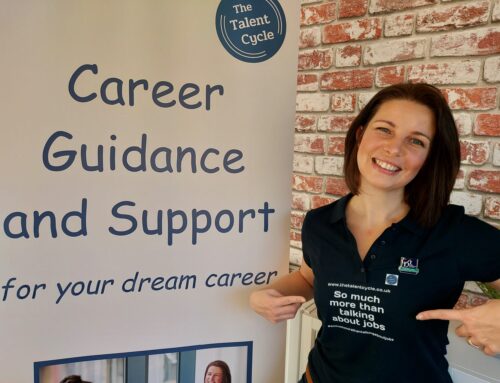It’s National Apprenticeship Week. Everywhere you look there is news about apprenticeships: information about the blue-chip employers who now use them, details of the vast range of occupations you can do one in and glossy campaigns selling the concept of apprenticeships to students, adult employees and, of course, careers advisors and teachers.

It is exciting and inspiring to hear that Amazon is one of the largest employers of apprentices in the country, that IBM rates its apprentices as highly as their graduates and that Google has run an apprenticeship programme for over ten years. It’s great to be able to share with students that it is not just traditional trades, like electricians, that you can enter via an apprenticeship, but careers in care, medicine, HR, law, finance, digital, data, engineering and so on and so on. And it is fantastic to share with students (and parents) the good news that getting an aspirational career does not have to mean taking on university debt.
More and more careers advisors and teachers now understand the value of apprenticeships, and not just for students who ‘can’t’ go to university, but for their brightest and most able too.
But when the ‘rubber hits the road’, and you and your students start looking for actual apprenticeship opportunities for them to consider, it suddenly seems so much harder.
Where are all these amazing apprenticeship opportunities? How can you help your students find and compare different ones side by side? Why does applying for them seem so complicated?
This is something I cover in my book, Understanding Apprenticeships: A Student’s Guide, published by Trotman, which I’m delighted to say has been an Amazon bestseller (reflecting the interest in apprenticeships as a subject, I suspect, as much as the beauty of my prose!) Here are some key points about finding apprenticeship opportunities from the book that I hope will help during this National Apprenticeship Week:
- Apprenticeships are jobs, first and foremost. This matters here, because the reality is that there are over 1 million employers in the UK who have needs for people throughout the year and often in unpredictable ways. It’s only really the largest employers who have the ability to have yearly, scheduled intakes of people starting their careers. If most employers cannot even predict when they will be interested in recruiting an apprentice, then don’t be hard on yourself if you can’t help your students predict it!
- UCAS is an incredible system for applying for university: one application to rule them all! The system fires off just one application to five institutions, all of whom are expecting it in exactly that format (and, by the way, most teachers and all careers advisors know exactly how to help a student complete it – lots of parents do as well). Even if a student doesn’t achieve their grades, the system kicks in again through clearing to automatically help again. It works because of the essential similarities between universities as institutions to which a student applies and because the ‘hiring’ (admissions process) happens at the same time of year, every year. The market for apprenticeships is not like this!
(The UCAS good news: UCAS has invested significantly in its apprenticeship ‘offer’ over the last few years, with more and more apprenticeships being showcased alongside university places – pushed by growing demand from students to see them. More investment is underway to trial simplified hiring through UCAS too. However, that may take time and won’t change the remaining factors…)
- Locations, sectors, timing: employers, sadly, are not evenly spread across the country; if you want to be a nuclear engineering apprentice, you need to live or move close to the dozen or so sites where your occupation exists; logistics opportunities are clustered in a smaller number of locations near major transport hubs; financial service opportunities tend to be in a few big cities; advanced manufacturing and engineering are in a greater number of locations – but they are also clustered in parts of the country; and even with jobs that are more evenly distributed (for example in care/medicine, HR, finance, leisure and hospitality), there will not always be the opportunities available at the time a young person is looking. And – a very common experience – is that a student might spot a great opportunity while doing their research in January: it is highly unlikely that it will still be open come the summer when they have completed the academic year.
So, what practical support can you offer your students to help them go about finding apprenticeship opportunities in a way that energises rather than worries them? Here are my suggestions:
- Explain that the job market is not like the ‘university market’: an apprenticeship is a real job (which is exactly why many students find it such an exciting option), but that means it is out there in the real economy where employers are responding to business fluctuations, sudden opportunities and an ever-changing set of employees. (By the way, this is exactly the same job market they will get to, albeit three years later, if they do a university degree – there is no magic ‘pass’ around this that a degree confers on you.) It is, quite simply put, inevitably messy.
- Please also explain that their choice about which apprenticeships to apply for and which ones to accept (and indeed, which university course they pick if that’s the route they go down) IS NOT FOREVER!! It does not determine, define or maybe, in lots of cases, even have much influence over the rest of their life. It’s a starting point only. So, they should think about trying to pick a starting point that they think they will enjoy, that they think will help them learn and that they think could be right for them. It doesn’t matter if they are wrong on one or all three of these things. No one can guarantee that their choice will be the ‘best’ one or even a good one. They will just have to give it a go. Please do this – the pressure on young people is enough as it is, they don’t need the false pressure of having to make a decision for life about their next step, when it really isn’t a decision for life.
- In light of point 2 above, it is sensible to adopt a strategy of having 3–4 ‘good’ apprenticeship aspirations in their mind, rather than 1 ‘perfect’ one. Option 1 might be what they think is their ‘ideal’ scenario but that is a bit of a long shot (maybe because it’s a competitive role, or because there are few such opportunities near where they live), option 2 might be more ‘gettable’ but in one field, the same might be true for option 3, and option 4 might be a ‘safe’ backup. Remind them that doing 18 months in one apprenticeship could help them understand – and move into – an aspiration that they currently don’t even know they have.
- Get your school or local library to buy my book and encourage your students to read the case studies in it, if nothing else. The case studies are of nine young people, just like them, who have been on the same journey. They will read about George who lost out on his ‘dream’ apprenticeship at Facebook, only to land in a totally different apprenticeship that has been the foundation for his (so far, very successful!) career. They will discover Finn who worked for four years in his chosen occupation before getting an apprenticeship in it. And of Kate who started as a volunteer during Covid that grew into her dream job (which just happened to be an apprenticeship).
- Dive into the many websites that have apprenticeship opportunities: UCAS, the government’s Find An Apprenticeship Service, amazingapprenticeships.com, notgoingtouni.com, thecareersguide.com, apprenticeshipguide.com (there are many!). And – just as importantly – encourage your students to talk to their parents, their parents’ friends, their parents’ friends’ friends and anyone they can to find out what job roles their employer is hiring for and whether these roles are, or could be, apprenticeships. This process of talking to real people in real jobs will do as much to help students understand what they want to do – and to find it – as looking at a bunch of websites or (dare I say?) as reading my book…
To find out more about apprenticeships, you can buy a copy Ben Rowland’s book, Understanding Apprenticeships.
Plus, get 25% off during National Apprenticeship with the discount code NAW24!

Ben is writing The Apprenticeship Guidebook, publishing this summer with Trotman Indigo Publishing, which is aimed at students and careers advisors to help them navigate their way around apprenticeships. Ben is an advisor to commercial, government and non-profit organisations when they want to bring about human-focused transformation. He is an expert in how organisations find, recruit, develop and get the best out of their people – their most important asset. Ben has a particular interest in apprenticeships. He was the founder of Arch Apprentices, one of the UK’s top ten apprenticeship providers and the first apprenticeship programme to work with the likes of Google and Facebook. He helped to launch a number of new apprenticeship programmes, such as the world’s first ever digital marketing apprenticeship and data and business analyst programmes. As a parent of teenagers, he is acutely aware of the minefield and difficult choices facing people as they come up to leaving full time education.






